Light ash brown hair color has emerged as one of the most sought-after shades in modern hair styling, captivating hearts with its cool-toned elegance and versatile charm.
This sophisticated hue strikes the perfect balance between blonde and brunette, offering a refined alternative to warmer brown tones while maintaining natural-looking depth and dimension.
Whether you’re looking to transition from dark hair, add subtle highlights, or completely transform your look, light ash brown provides endless possibilities for customization.
This comprehensive guide explores over 27 stunning variations of light ash brown hair color, from classic solid shades to contemporary balayage techniques, helping you discover the perfect tone to complement your skin undertone, lifestyle, and personal style preferences.
Contents
- 1 1. Classic Light Ash Brown Base Color
- 2 2. Light Ash Brown Balayage
- 3 3. Ash Brown with Platinum Highlights
- 4 4. Cool-Toned Ash Brown Ombre
- 5 5. Ash Brown with Silver Undertones
- 6 6. Subtle Ash Brown Highlights
- 7 7. Ash Brown Babylights
- 8 8. Ash Brown Lowlights on Blonde Hair
- 9 9. Light Ash Brown Bob
- 10 10. Ash Brown Beach Waves
- 11 11. Rooted Ash Brown
- 12 12. Ash Brown with Caramel Peekaboo Highlights
- 13 13. Ash Brown Curtain Bangs
- 14 14. Mushroom Ash Brown
- 15 15. Ash Brown Money Piece
- 16 16. Bronde with Ash Tones
- 17 17. Ash Brown Ponytail
- 18 18. Ash Brown Pixie Cut
- 19 19. Ash Brown with Face-Framing Layers
- 20 20. Ash Brown Braided Styles
- 21 21. Ash Brown Highlights on Dark Hair
- 22 22. Ash Brown Color Melt
- 23 23. Ash Brown with Violet Tones
- 24 24. Textured Ash Brown Lob
- 25 25. Ash Brown Root Stretch
- 26 26. Ash Brown Glass Hair
- 27 27. Ash Brown Shag Cut
- 28 Maintenance Tips for Light Ash Brown Hair
- 29 Choosing the Right Ash Brown Shade for Your Skin Tone
- 30 Cost Considerations for Light Ash Brown Hair
- 31 Protecting Ash Brown Hair from Environmental Damage
- 32 Styling Products Best Suited for Ash Brown Hair
- 33 Transitioning to Light Ash Brown from Other Colors
- 34 Common Mistakes to Avoid with Ash Brown Hair
- 35 Seasonal Considerations for Ash Brown Hair
- 36 Conclusion
1. Classic Light Ash Brown Base Color

The foundation of timeless elegance begins with a classic light ash brown base that serves as the cornerstone for countless styling variations.
This universally flattering shade eliminates brassy undertones while delivering a sophisticated, cool-toned appearance that works beautifully across all seasons.
- The classic light ash brown base provides a level 6-7 depth on the hair color scale, positioning it perfectly between medium brown and dark blonde territories.
- This shade works exceptionally well for individuals with cool or neutral skin undertones, as the ash tones complement pink and neutral complexions without creating unwanted warmth.
- Professional colorists achieve this look by combining brown base pigments with blue and violet toners that neutralize any orange or red undertones naturally present in hair.
- Maintenance requires purple or blue-toned shampoos used once weekly to preserve the cool ash quality and prevent color from shifting toward warmer brassiness.
- The longevity of this color typically extends 6-8 weeks before requiring root touch-ups, making it a relatively low-maintenance option compared to lighter blonde shades.
2. Light Ash Brown Balayage
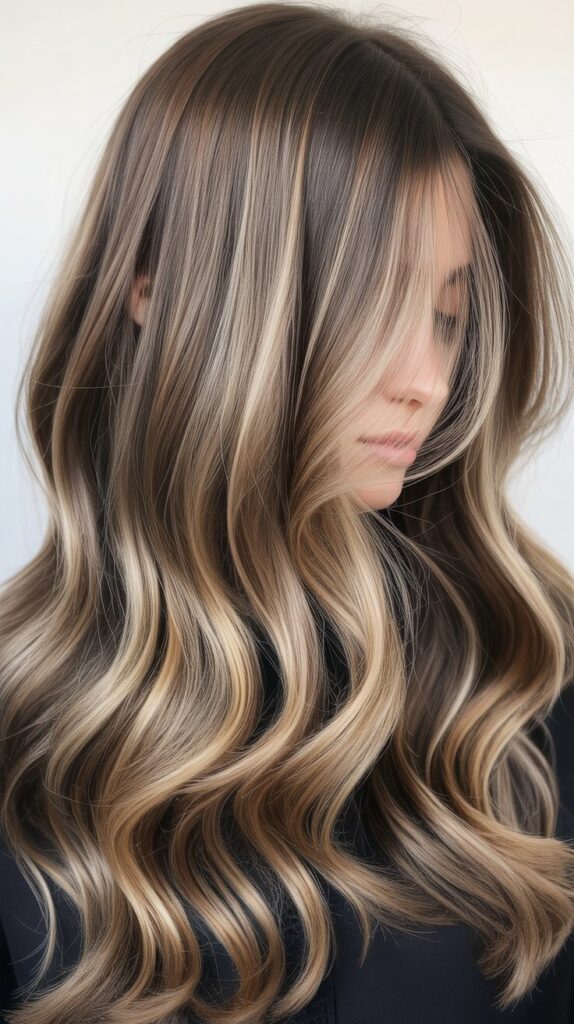
Balayage technique transforms light ash brown into a multidimensional masterpiece that mimics the natural sun-kissed effect with artistic hand-painting precision.
This method creates seamless color transitions that grow out gracefully without harsh demarcation lines.
- Balayage allows colorists to strategically place lighter ash brown pieces around the face, creating a brightening effect that enhances facial features and adds youthful radiance.
- The technique involves painting color onto select sections rather than saturating entire strands, resulting in a more natural appearance with varied tonal depth throughout.
- Light ash brown balayage typically incorporates 2-3 different shades within the ash brown family, creating dimension that catches light beautifully from multiple angles.
- This coloring method proves ideal for those wanting lower maintenance, as the intentionally soft root area means regrowth blends naturally for 3-4 months between appointments.
- Styling wavy or curled hair showcases balayage dimension most effectively, as the movement reveals the interplay of different ash brown tones throughout the hair.
3. Ash Brown with Platinum Highlights

The dramatic contrast between light ash brown base and platinum highlights creates a bold, fashion-forward statement that commands attention.
This high-contrast combination delivers edgy sophistication while maintaining enough depth to avoid the high-maintenance demands of full platinum hair.
- Platinum highlights placed strategically throughout light ash brown hair create a striking dimensional effect that appears almost three-dimensional under various lighting conditions.
- This color combination requires significant pre-lightening of selected sections, often requiring multiple bleaching sessions to achieve the pale platinum tone without compromising hair integrity.
- Colorists recommend keeping platinum pieces concentrated around the face and crown area where they provide maximum impact while minimizing overall damage to the hair.
- Maintenance demands are higher with this style, requiring purple shampoo for platinum sections and ash-toning products for brown areas, typically every 8-10 weeks for touch-ups.
- Heat styling with lower temperatures becomes essential to preserve both the platinum and ash brown sections from potential color fading and damage.
4. Cool-Toned Ash Brown Ombre

Ombre styling in light ash brown tones creates a graduated color journey from darker roots to lighter ends, offering a contemporary take on traditional hair coloring.
The cool ash undertones keep this gradient looking sophisticated rather than brassy or overly warm.
- The ombre technique typically begins with natural or darkened roots in a deeper ash brown shade (level 4-5) that gradually lightens toward level 7-8 at the ends.
- Cool ash tones throughout the gradient prevent the common problem of mid-shaft brassiness that often plagues traditional ombre applications with warmer base colors.
- This style offers exceptional low-maintenance appeal, as roots can grow out naturally for several months without requiring touch-ups, making it budget-friendly long-term.
- The transition zone, typically positioned between ear and chin level, requires expert blending to avoid harsh lines while maintaining distinct color differentiation between sections.
- Long hair showcases ombre effects most dramatically, though medium-length hair can successfully carry this look with proper placement of the transition area.
5. Ash Brown with Silver Undertones
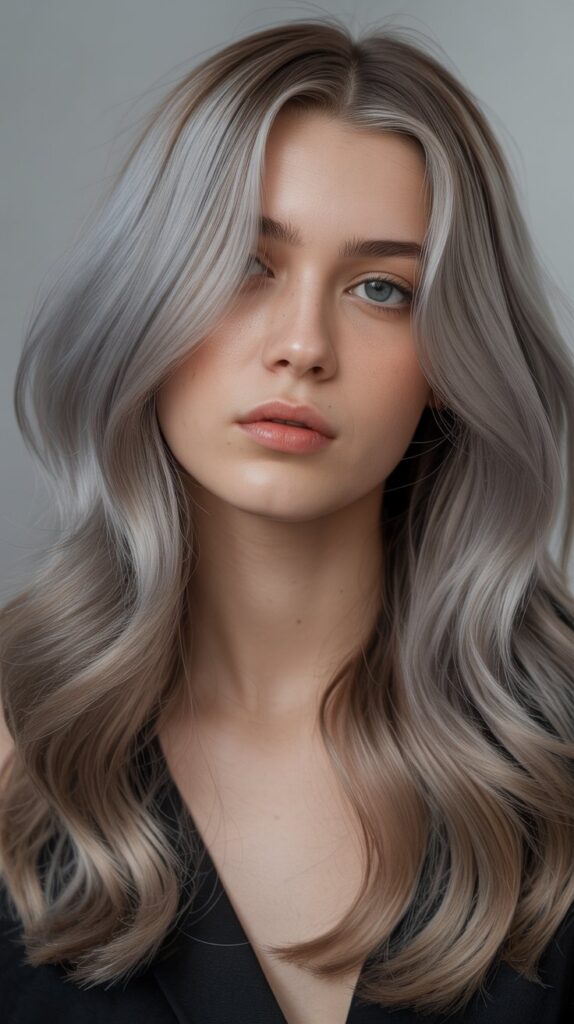
Infusing light ash brown with silver undertones creates an ethereal, almost mystical hair color that bridges the gap between natural and fashion-forward styling.
This metallic-influenced shade appeals to those seeking something unique while maintaining workplace-appropriate sophistication.
- Silver-infused ash brown requires specialized toners containing gray and violet pigments that create the signature metallic sheen characteristic of this color family.
- The silver undertones become most visible in bright natural light or sunlight, where they create an almost iridescent quality that shifts between brown and silver depending on viewing angle.
- This color works particularly well on individuals with very pale or cool-toned skin, as the silver elements complement rather than clash with naturally cool complexions.
- Maintaining the silver quality requires dedicated silver or purple shampoos used 2-3 times weekly, along with regular glossing treatments every 4-6 weeks to refresh the metallic tone.
- Hair must be pre-lightened to at least level 8-9 before applying silver-ash toners, ensuring the hair is light enough to reflect the delicate silver pigments properly.
6. Subtle Ash Brown Highlights
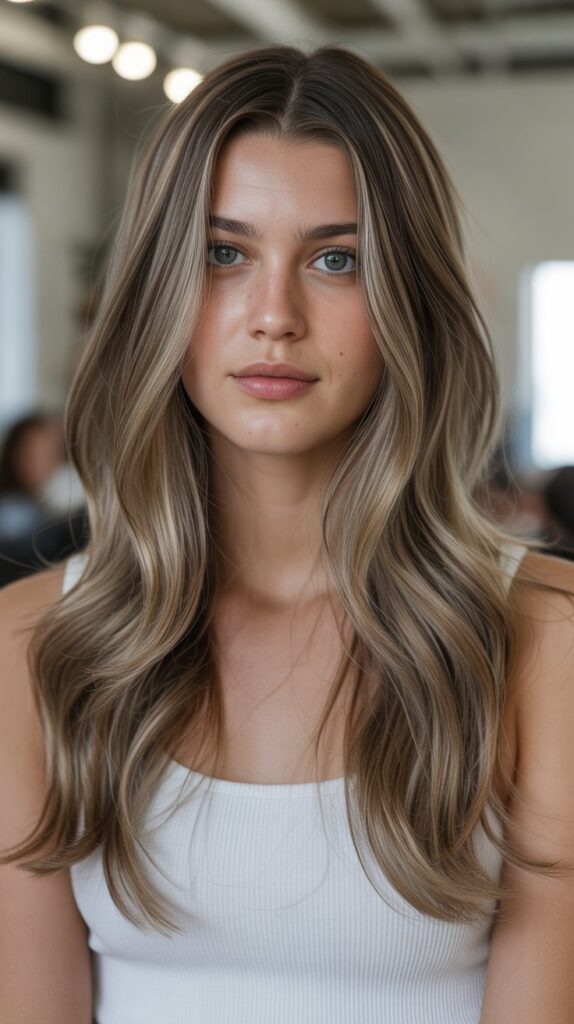
For those preferring understated elegance over dramatic transformation, subtle ash brown highlights provide gentle dimension that enhances natural beauty without overwhelming it.
This conservative approach to color adds interest while maintaining professional versatility.
- Subtle highlights typically incorporate shades only 1-2 levels lighter than the base color, creating whisper-soft dimension that appears almost natural rather than obviously colored.
- Placement focuses on areas where sun would naturally lighten hair—around the face, crown, and top layers—creating an authentic sun-kissed appearance year-round.
- This highlighting technique uses fine weaving or baby lights methods, selecting ultra-thin sections of hair to ensure seamless blending with the natural base color.
- Maintenance requirements remain minimal, with touch-ups needed only every 10-12 weeks as the subtle nature means regrowth blends imperceptibly with the existing color.
- Styling straight or with gentle waves allows the subtle highlights to peek through naturally without requiring dramatic curls to showcase the dimensional effect.
7. Ash Brown Babylights

Babylights represent the most delicate highlighting technique, creating ultra-fine ribbons of lighter ash brown throughout the hair that mimic the natural highlights seen in children’s hair.
This technique delivers maximum naturalness with stunning dimensional results.
- Babylights require exceptional precision from colorists who select individual strands or extremely thin sections, often no thicker than a few hairs, for targeted lightening.
- The result creates a soft-focus effect throughout the hair where no single highlight draws attention, yet the overall appearance shows remarkable depth and movement.
- This technique proves ideal for first-time color clients or those transitioning from virgin hair, as the subtle nature feels less dramatic than traditional highlighting.
- Application time significantly exceeds standard highlighting due to the meticulous section selection, often requiring 3-4 hours in the salon for a full head of babylights.
- Babylights grow out more gracefully than any other highlighting technique, often remaining attractive for 12-16 weeks before requiring professional refreshing.
8. Ash Brown Lowlights on Blonde Hair
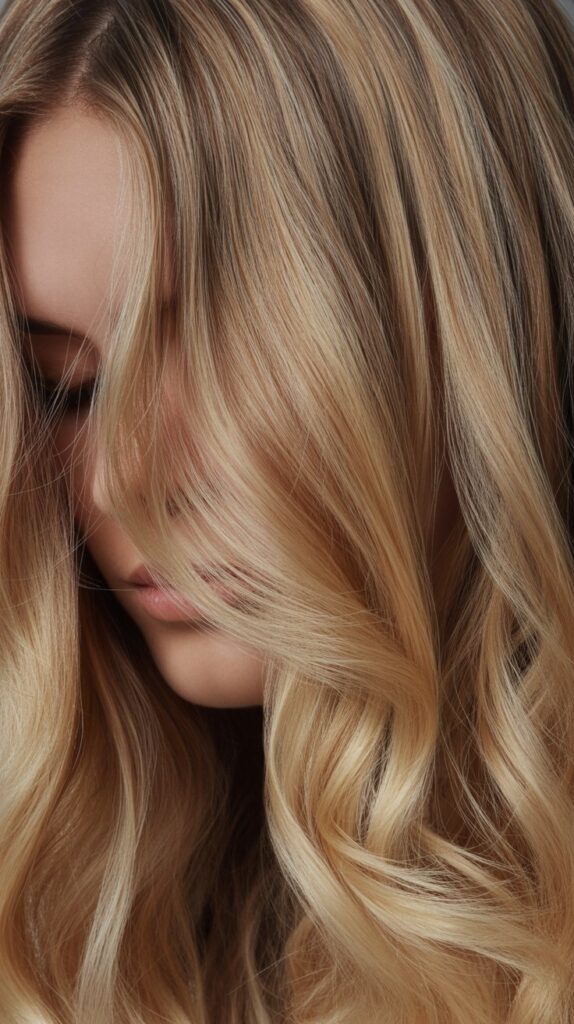
For blondes seeking to add depth and dimension without fully committing to brunette territory, ash brown lowlights offer the perfect compromise.
This reverse highlighting technique creates richness and prevents the flat, one-dimensional appearance of solid blonde.
- Lowlights work by adding darker ash brown tones into blonde hair, creating valleys of shadow that make lighter blonde areas appear even brighter by contrast.
- This technique proves especially valuable for natural blondes experiencing color fading, as the lowlights restore depth without requiring complete color overhaul.
- Strategic placement of lowlights around the hairline and underneath sections creates a rooting effect that extends time between full color services by camouflaging regrowth.
- The ash tone selection for lowlights remains critical, as warm-toned browns would create an unflattering contrast with cool blonde bases.
- Maintenance scheduling typically alternates between root touch-ups and lowlight refreshing, with each service occurring every 8-10 weeks for optimal appearance.
9. Light Ash Brown Bob
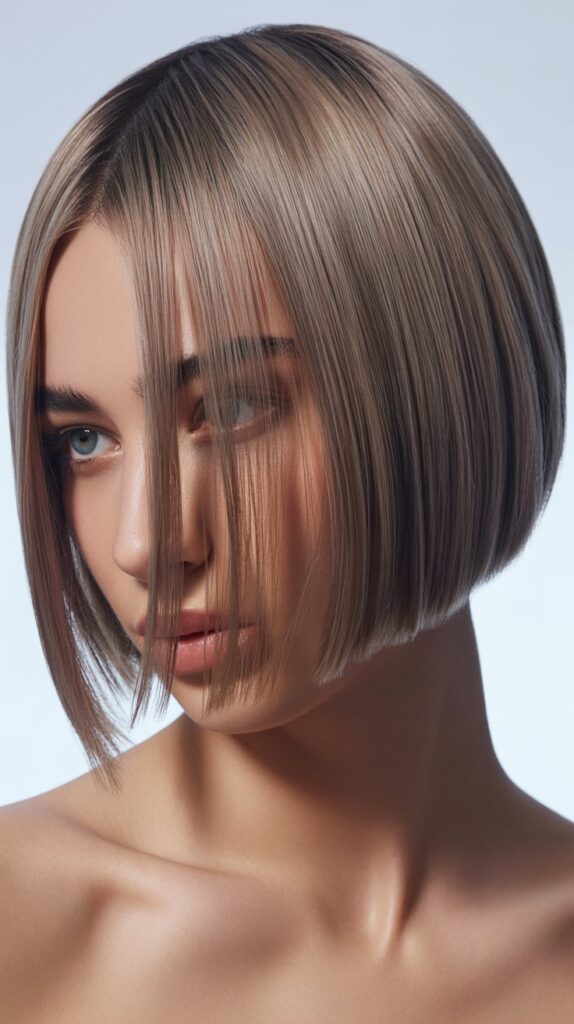
The bob haircut paired with light ash brown color creates a chic, contemporary statement that exudes confidence and modern sophistication.
This combination showcases the color’s cool elegance while the structured cut provides clean lines and shape.
- The bob’s shorter length means less surface area for color to fade or become damaged, helping maintain the pristine ash tone with less intensive maintenance than longer styles.
- Blunt bob cuts create a solid canvas that displays even, all-over ash brown color beautifully, while layered bobs can incorporate subtle dimension through tonal variation.
- Face-framing angles in asymmetrical or A-line bobs benefit from slightly lighter ash pieces that brighten the complexion and draw attention to facial features.
- The precision required for bob cuts means regular trimming every 6-8 weeks becomes essential, which conveniently aligns with color touch-up scheduling.
- Styling flexibility ranges from sleek straight looks that emphasize color uniformity to textured waves that add movement while showcasing any dimensional coloring present.
10. Ash Brown Beach Waves
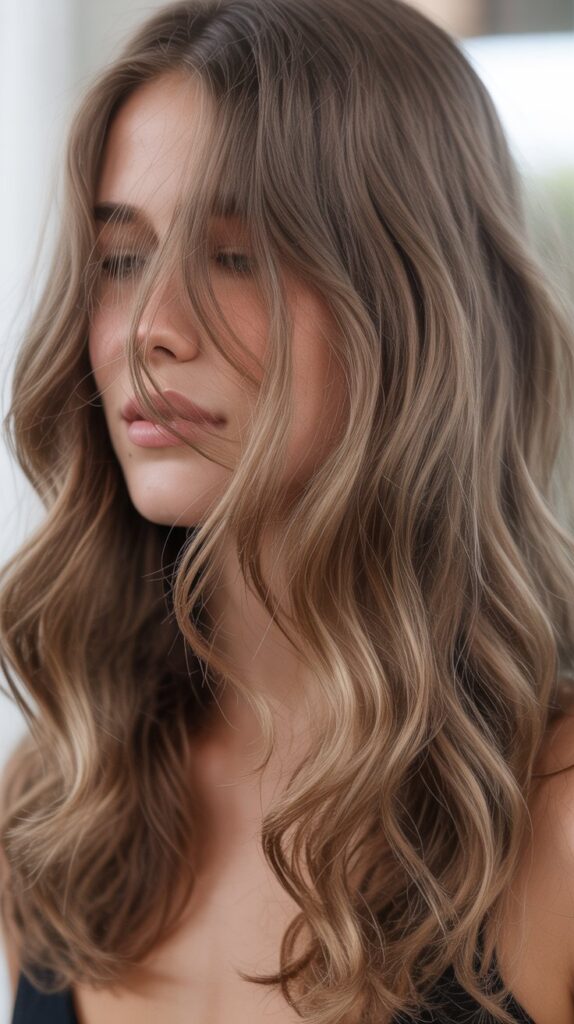
Combining the relaxed texture of beach waves with the refined coolness of light ash brown creates a perfectly balanced look that reads both effortless and polished.
This pairing has become increasingly popular for its versatile, year-round appropriateness.
- Beach wave texture reveals dimensional coloring more effectively than straight styles, as the curves and bends catch light differently, showcasing various tonal depths throughout the hair.
- The intentionally imperfect nature of beach waves complements the cool sophistication of ash brown by preventing the color from appearing too formal or severe.
- Achieving this texture requires sea salt spray or texturizing products applied to damp hair, often paired with diffusing or air-drying techniques rather than precise heat styling.
- The ash brown tone prevents beach waves from looking overly casual or messy, adding an element of refinement that makes this combination appropriate for various settings from office to evening events.
- Maintenance of both color and style remains relatively simple, as beach waves embrace natural texture and the ash tone gracefully handles the slight tousling and natural oils that enhance wave definition.
11. Rooted Ash Brown
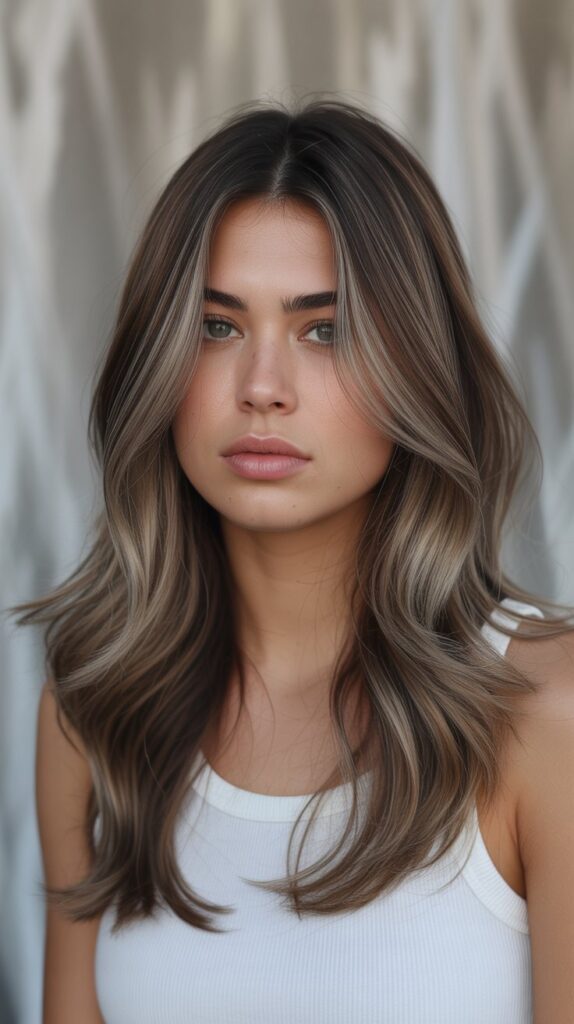
The rooted ash brown technique intentionally leaves or creates darker roots while maintaining lighter ash brown through mid-lengths and ends, offering a lived-in appearance that requires minimal maintenance.
This approach has revolutionized color maintenance expectations.
- The shadow root technique typically keeps 1-3 inches of roots darker (usually 2-3 levels deeper) than the rest of the hair, creating an intentional gradient that mimics natural regrowth.
- This coloring strategy significantly extends time between salon visits, with many clients comfortably waiting 12-16 weeks before requiring any color service.
- The darker root area adds visual depth to the overall color while preventing the harsh demarcation line that occurs with traditional single-process coloring as natural hair grows.
- Colorists can create shadow roots through various methods including root smudging, melting, or simply leaving natural roots untouched during the coloring process.
- The technique works particularly well for busy individuals or those seeking to minimize chemical exposure and salon expenses while maintaining fashionable, dimensional color.
12. Ash Brown with Caramel Peekaboo Highlights

While ash brown typically maintains cool tones, strategically placed warm caramel peekaboo highlights create unexpected pops of contrast hidden beneath the surface layers.
This playful combination adds personality while maintaining professional versatility.
- Peekaboo highlights remain hidden in underlayers of hair, revealing themselves only when hair moves or is styled in updos, providing surprise elements of warmth against the cool ash canvas.
- The caramel tones offer a striking visual pop when revealed while remaining completely concealed during conservative styling, making this ideal for those with strict professional appearance requirements.
- This technique requires sectioning hair precisely, often coloring only the bottom 1-3 inches of underlayer hair or specific sections around the nape and sides.
- The contrast between cool ash surface and warm caramel underneath creates depth illusion, making hair appear thicker and more voluminous than single-tone coloring.
- Maintenance focuses primarily on the ash brown surface areas, with peekaboo sections requiring attention less frequently since they remain mostly hidden from sun exposure and environmental factors.
13. Ash Brown Curtain Bangs
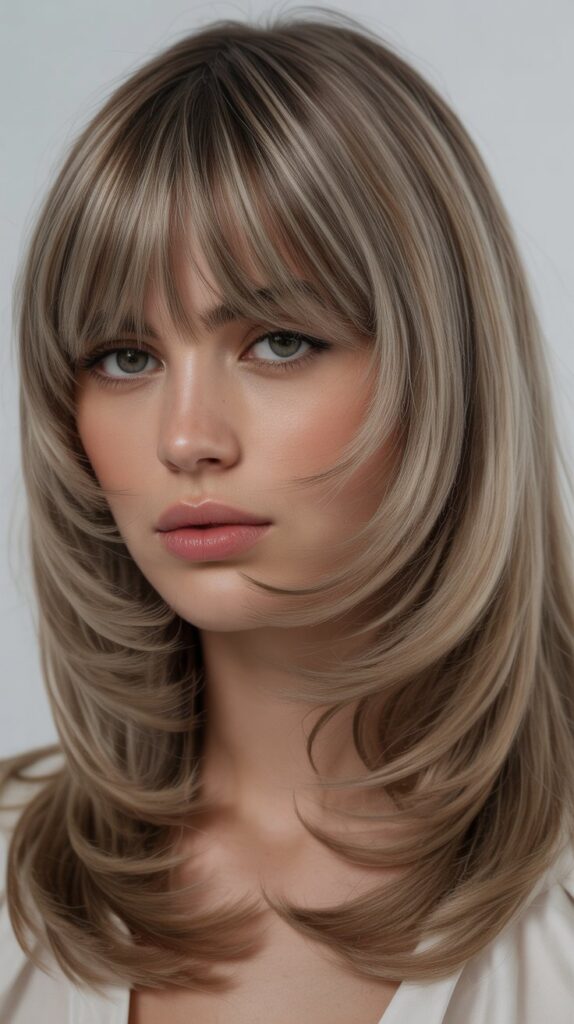
Curtain bangs framing the face in light ash brown create a retro-inspired yet thoroughly modern look that flatters virtually every face shape.
The combination of this trending haircut with sophisticated ash brown coloring delivers timeless style with contemporary edge.
- Curtain bangs typically part in the center and sweep to either side of the face, with the ash brown color providing subtle framing that enhances features without overpowering them.
- The lighter ash brown tone on bangs brightens the eye area and creates a soft, flattering frame that works especially well with cool or neutral skin undertones.
- Styling requires round-brushing or straightening the bangs away from the face while the rest of the hair can embrace natural texture, creating an intentionally styled-yet-effortless appearance.
- The shorter length of curtain bangs means this hair requires more frequent trimming (every 4-6 weeks) to maintain the proper length and prevent bangs from hanging into eyes.
- Color touch-ups for bangs may be needed more frequently than the rest of the hair since they frame the face prominently and any root growth or fading becomes immediately noticeable.
14. Mushroom Ash Brown
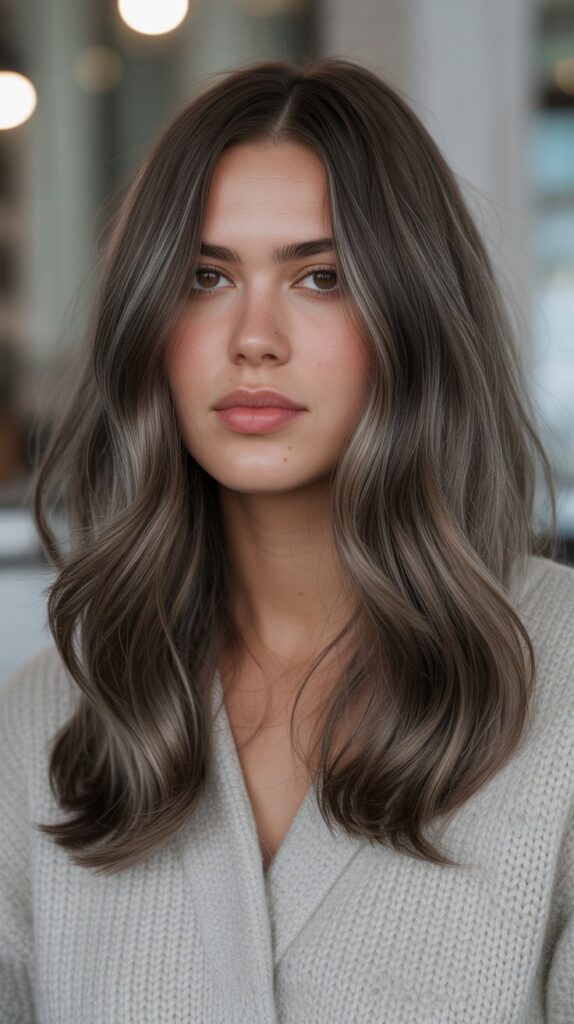
Mushroom brown represents a unique interpretation of ash brown that incorporates subtle gray-brown tones reminiscent of mushroom caps, creating an earthy yet sophisticated shade that has gained cult following among fashion-forward clients.
- Mushroom brown sits in a unique color space between traditional ash brown and gray-brown, typically achieved at level 6-7 with heavy ash and slight gray toning.
- This shade particularly flatters individuals with cool or olive skin tones, as the muted gray-brown creates harmonious contrast without introducing warmth.
- Achieving mushroom brown often requires pre-lightening hair to ensure the base is neutral enough to accept the cool gray-brown pigments without distortion.
- The color carries a slightly matte quality rather than high-shine finish, contributing to its earthy, natural mushroom-like appearance that sets it apart from glossier ash browns.
- Maintenance requires specialized gray-toning shampoos and glossing treatments every 4-6 weeks to prevent the delicate gray undertones from oxidizing toward warmer or brassy tones.
15. Ash Brown Money Piece
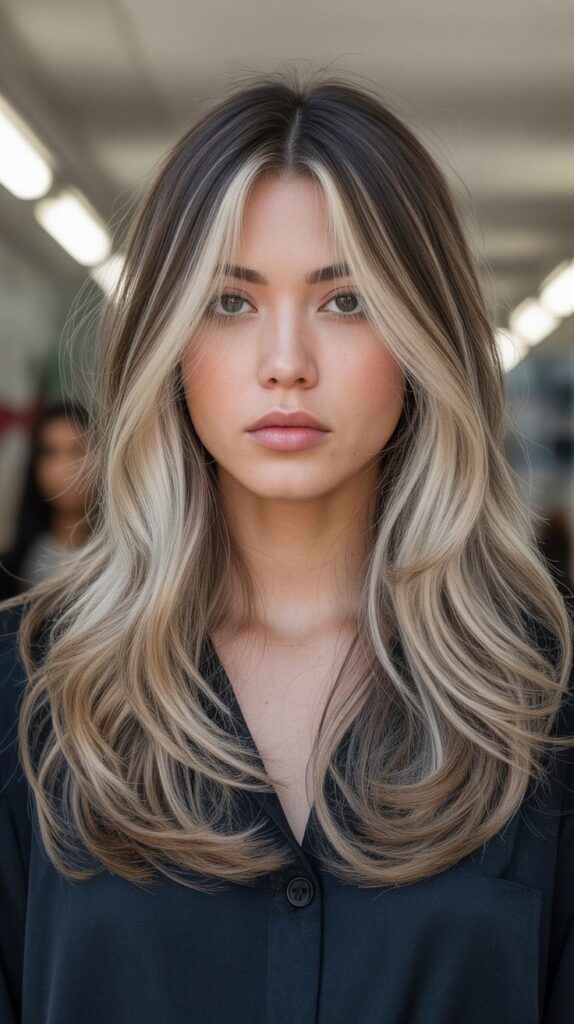
The money piece technique places bold, lighter ash brown or ash blonde highlights framing the face, creating an attention-grabbing focal point that brightens and lifts facial features dramatically.
This trend offers maximum impact with strategic, minimal coloring.
- Money pieces typically span 1-2 inch sections on either side of the face, lightened 3-4 levels above the base ash brown color for striking, high-impact contrast.
- This placement strategically draws attention to the face, acting like a built-in highlighter that emphasizes cheekbones, eyes, and creates the illusion of facial contouring.
- The technique requires significantly less time and expense than full highlighting since color application remains concentrated in small, specific areas rather than throughout entire head.
- Money pieces grow out less obtrusively than traditional highlights since they exist in visible, intentional sections rather than attempting to blend seamlessly throughout all hair.
- Styling with the hair worn down showcases money pieces optimally, though they also create interesting contrast when hair is pulled back into ponytails or updos.
16. Bronde with Ash Tones
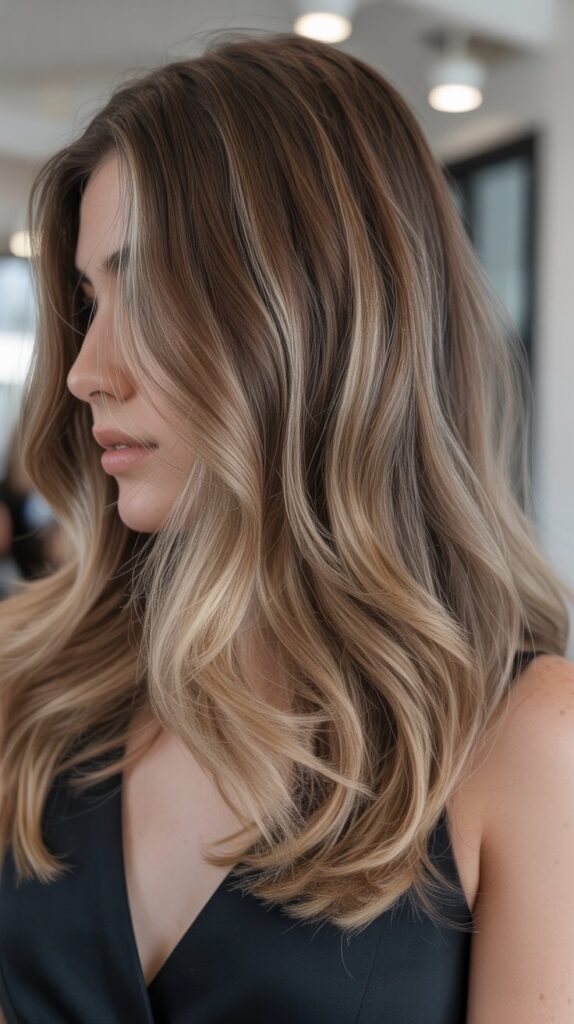
Bronde—the perfect fusion of brown and blonde—takes on sophisticated new dimensions when executed in ash tones, eliminating any brassy warmth for a cooler, more modern interpretation of this popular hybrid color.
- Ash-toned bronde typically combines level 6-7 ash brown with level 7-8 ash blonde in a strategic blend that creates ambiguity about whether the base color reads primarily as brown or blonde.
- This color proves exceptionally flattering on a wide range of skin tones since the ash undertones prevent the warmth issues that plague traditional golden bronde applications.
- Achieving bronde requires expert color melting or blending techniques to ensure the brown and blonde elements flow seamlessly without creating obvious stripey or blocky patterns.
- The dimensional nature means that bronde appears to shift in different lighting conditions, sometimes reading more brown in indoor lighting and more blonde in bright sunlight.
- Maintenance involves balancing both the brown and blonde components, typically requiring alternating toning treatments to address each color family’s specific fading patterns every 6-8 weeks.
17. Ash Brown Ponytail
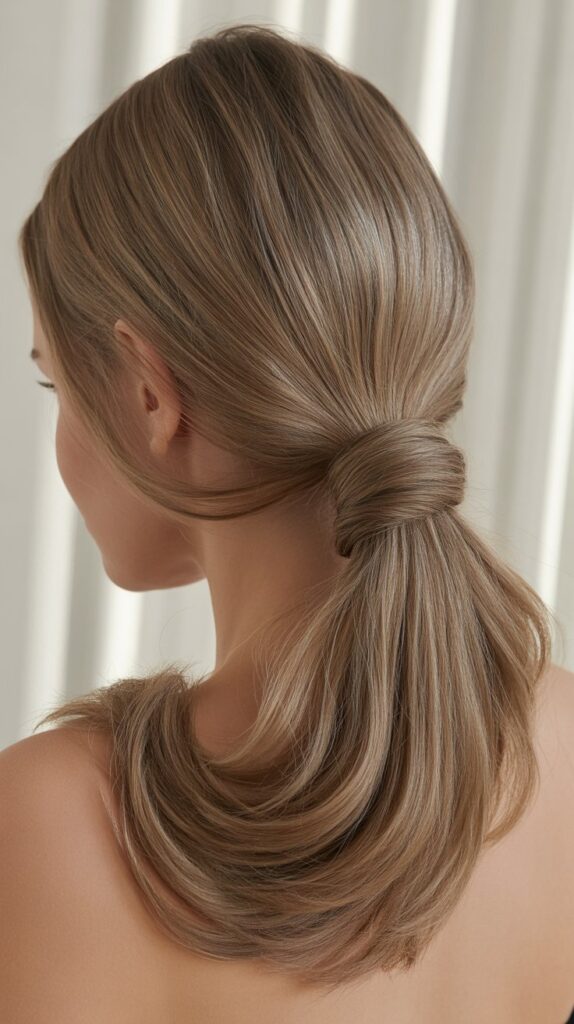
While not a color technique itself, the ponytail hairstyle showcases light ash brown’s dimensional qualities uniquely, as pulling hair back reveals undertones, lowlights, and the color’s true depth in ways that down styles conceal.
- Ponytails reveal the color uniformity or dimension throughout hair length, making proper color placement and toning particularly important for this frequently worn style.
- The tension and gathering of hair in ponytails can expose any root regrowth or color fading more obviously than hair worn down, necessitating more diligent maintenance schedules.
- Light ash brown in ponytails reflects light beautifully due to the hair’s alignment and smoothness, creating a glossy, healthy appearance that makes the cool tones particularly striking.
- Adding dimension through balayage or highlights becomes especially important for those wearing ponytails frequently, as the gathered style benefits from the tonal variation that prevents flatness.
- The hair tie placement can strategically cover slight root regrowth or less-than-perfect color, offering styling flexibility between salon appointments.
18. Ash Brown Pixie Cut
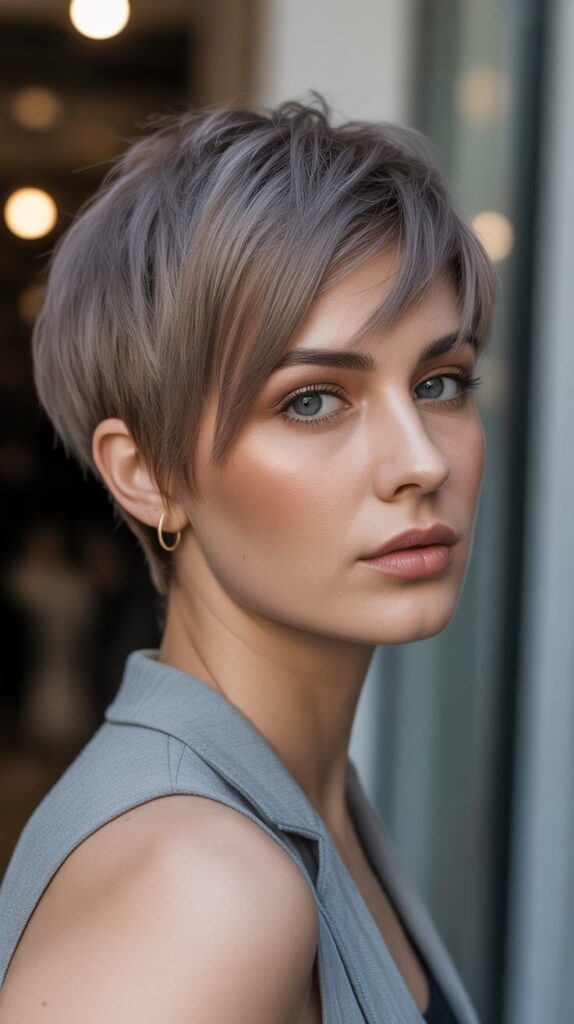
The pixie cut paired with light ash brown creates a bold, confident statement that emphasizes facial features while the cool ash tones add sophistication to this daring short style.
- Short pixie cuts require more frequent color maintenance than longer styles since new growth becomes visible more quickly, typically necessitating root touch-ups every 4-5 weeks.
- The minimal hair surface area means color services use less product and take less time, often making pixie color maintenance more budget-friendly despite more frequent appointments.
- Ash brown tones particularly suit pixie cuts as the cool sophistication prevents the short style from appearing too harsh or severe, adding softness through color choice.
- Styling versatility in pixies allows the ash brown color to showcase differently depending on whether hair is slicked back, tousled, or worn with textured spikiness.
- The dramatic nature of pixie cuts means the ash brown color becomes a defining feature of the overall look, requiring pristine maintenance to keep the color fresh and vibrant.
19. Ash Brown with Face-Framing Layers
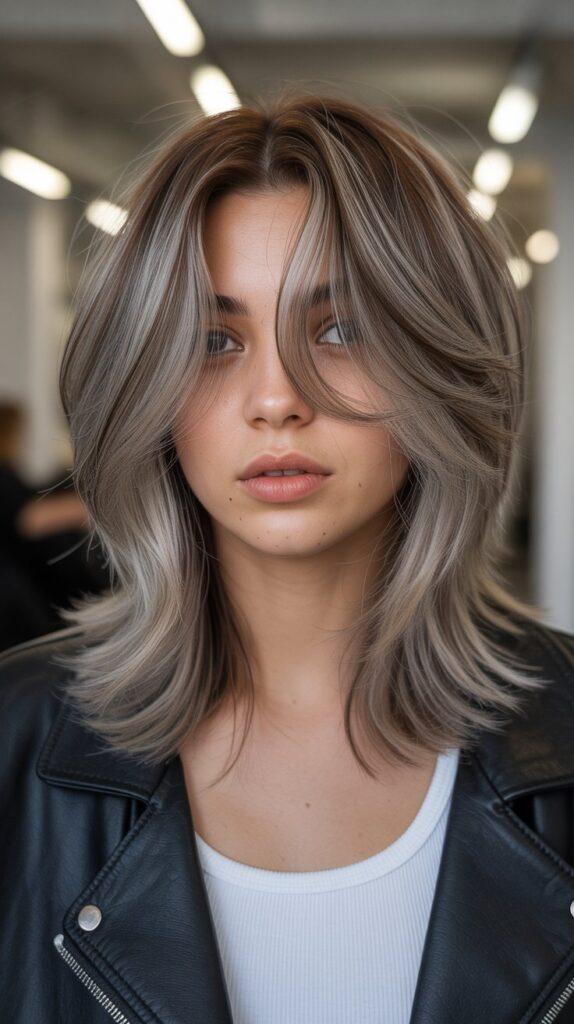
Face-framing layers cut into light ash brown hair create movement and dimension while the strategic layering allows for customized color placement that enhances individual facial features and bone structure.
- Face-framing layers typically begin around cheekbone or chin level, creating a graduated effect that can be enhanced with slightly lighter ash tones for additional brightening.
- The layered structure allows light to interact with hair differently at various lengths, naturally showcasing the ash brown’s depth and any dimensional coloring present.
- Styling face-framing layers with waves or curls creates maximum impact, as the movement reveals the interplay between different layer lengths and color tones.
- Layers require more frequent trimming than blunt cuts to maintain their shape and prevent the dimensional effect from appearing grown-out or unkempt, typically every 6-8 weeks.
- Color placement on layers can be customized strategically, with lighter ash pieces placed in the shortest face-framing sections for maximum facial brightening impact.
20. Ash Brown Braided Styles
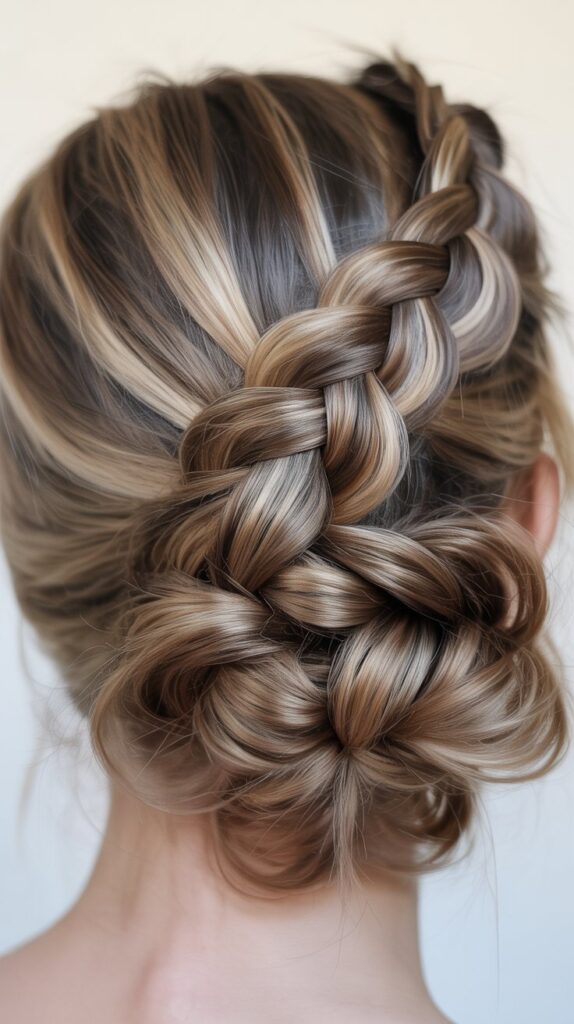
Braided hairstyles in light ash brown showcase the color’s dimensional qualities through the interweaving strands, creating visual interest where cool ash tones play across the textured surface of plaits and weaves.
- Braids reveal any dimensional coloring exceptionally well, as the weaving process displays hair from multiple angles and creates shadows and highlights that emphasize tonal variation.
- The textured surface of braids makes ash brown appear more matte and earthy rather than glossy, creating an interesting contrast to the color’s typical sleek appearance when worn straight.
- Simple three-strand braids, Dutch braids, fishtails, and complex multi-strand weaving all showcase ash brown beautifully while maintaining appropriate formality for various occasions.
- Hair products should be minimal when braiding ash brown hair to prevent color-dulling buildup, focusing instead on pre-braid preparation that ensures hair is clean and properly toned.
- Braided styles offer protective benefits for colored hair by reducing exposure to environmental factors and heat styling that contribute to ash tone fading over time.
21. Ash Brown Highlights on Dark Hair

Transitioning from dark hair to light ash brown through strategic highlighting creates a less dramatic pathway than all-over color while still achieving significant lightening with cool-toned sophistication.
- Highlights on dark hair typically require multiple sessions spaced 4-6 weeks apart to safely lighten hair from level 3-4 to level 6-7 ash brown without excessive damage.
- The contrast between dark base and lighter ash highlights creates striking dimension that makes hair appear fuller and more voluminous than single-tone dark coloring.
- Strategic placement around the face, crown, and through ends provides maximum impact while leaving enough dark base to maintain depth and minimize root maintenance.
- Toning remains crucial after highlighting dark hair to ensure the lifted sections achieve true ash brown rather than pulling warm or orange, requiring violet and blue-based toners.
- This graduated approach to lightening proves less shocking than dramatic color changes, allowing clients to adjust to lighter hair progressively while minimizing damage.
22. Ash Brown Color Melt

Color melting technique creates seamless transitions between different ash brown shades, eliminating harsh lines for a gradient effect that appears almost painted onto the hair with artistic precision.
- Color melting typically combines 2-4 different levels within the ash brown family, with darker tones at roots gradually transitioning to lighter ash at ends without visible demarcation.
- The technique requires expert blending at the color overlap zones, often using a “melting” process where toner is worked through the transition areas while partially processing.
- This approach creates remarkably low-maintenance color since the intentional gradient means new growth blends naturally into the existing color story without obvious regrowth lines.
- Styling with gentle waves or straight textures both showcase color melt beautifully, as the seamless transitions remain visible regardless of hair texture or styling choice.
- Refresh timing varies based on the number of shades used and their contrast, though most color melts remain attractive for 10-14 weeks before requiring professional attention.
23. Ash Brown with Violet Tones

Infusing light ash brown with subtle violet undertones creates a unique color interpretation that leans cooler and more fashion-forward while the purple notes add unexpected dimension and neutralize warmth exceptionally well.
- Violet tones in ash brown are achieved through purple-based toners applied after lightening, with the intensity of purple varying based on desired effect from barely perceptible to obviously violet-tinged.
- The violet undertones become most visible in certain lighting conditions, particularly natural daylight and fluorescent lighting where they create an almost iridescent quality.
- This color variation particularly suits individuals seeking something unique within the ash brown family while maintaining enough naturalness for conservative environments.
- Purple-toned shampoos become especially important for maintenance, used 2-3 times weekly to preserve the violet notes that fade more quickly than the brown base.
- The violet infusion provides exceptional brass-canceling properties, making this variation ideal for those whose hair tends to pull warm or orange between color appointments.
24. Textured Ash Brown Lob
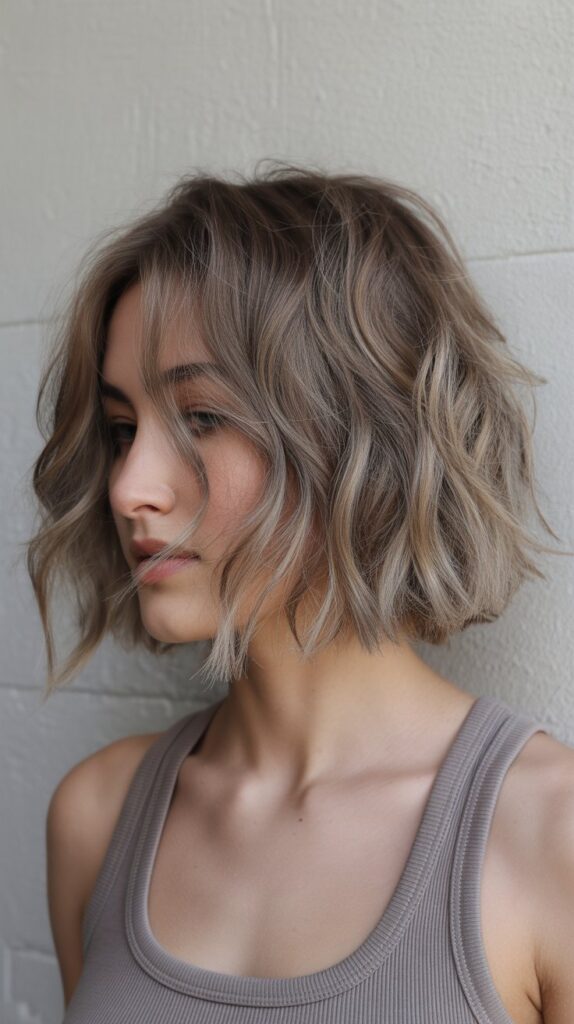
The long bob (lob) cut paired with textured styling and light ash brown color creates one of the most versatile, modern looks available, offering length flexibility while the ash tones provide sophistication to the intentionally undone texture.
- The lob length falls between chin and shoulders, providing enough length for styling versatility while remaining short enough that the ash brown color doesn’t require excessive maintenance products or time.
- Texturing through the lob cut creates movement that showcases any dimensional ash brown coloring, with the varied lengths catching light differently to reveal tonal depth.
- This combination proves exceptionally popular because it strikes the perfect balance between polished and effortless, appropriate for professional settings yet relaxed enough for casual environments.
- Styling the textured lob requires minimal products—typically just texturizing spray or sea salt spray—making it ideal for those seeking low-maintenance daily hair routines despite colored hair.
- The lob length grows out gracefully while maintaining its shape for 8-10 weeks between cuts, conveniently aligning with color maintenance schedules for efficient combined appointments.
25. Ash Brown Root Stretch
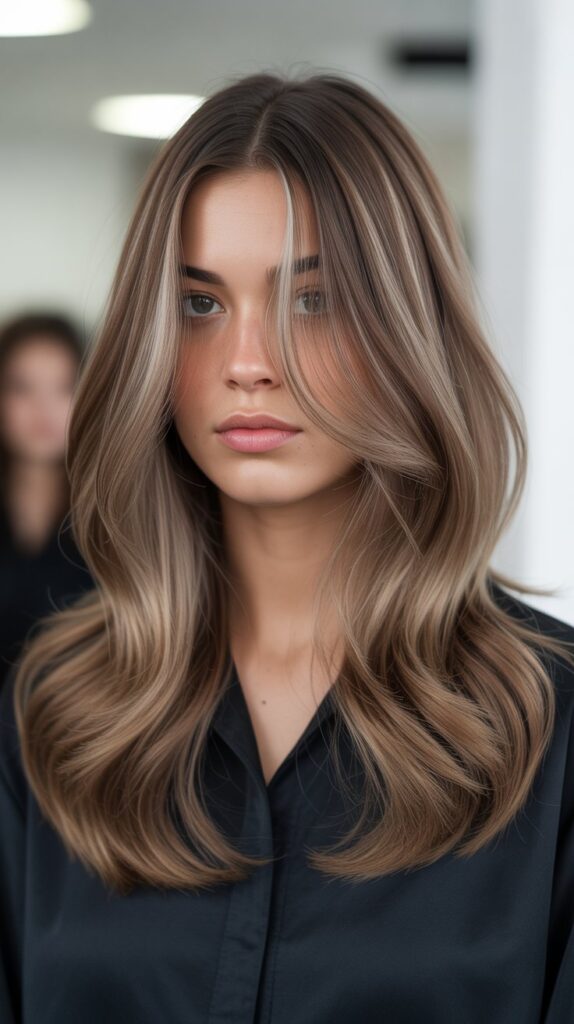
Root stretching intentionally blurs the line between natural roots and colored lengths, creating a soft gradient in the root area that extends time between touch-ups while maintaining the polished appearance of fresh color.
- Root stretching applies darker ash brown through the root zone (typically 2-4 inches from scalp) with gradual lightening toward the mid-lengths, creating intentional depth that mimics natural regrowth.
- This technique can extend time between color appointments to 10-16 weeks depending on natural hair color and growth rate, significantly reducing maintenance demands and chemical exposure.
- The blurred transition zone eliminates the harsh line that occurs with traditional single-process color, creating a more forgiving grow-out that remains attractive throughout the maintenance cycle.
- Colorists achieve root stretching through various methods including root smudging, shadow rooting, or targeted application that leaves roots darker while coloring lengths to desired ash brown.
- The technique proves particularly valuable for those with fast-growing hair or darker natural colors, as the intentional depth prevents the stark contrast that typically necessitates frequent touch-ups.
26. Ash Brown Glass Hair

The glass hair trend emphasizes mirror-like shine and smoothness, with light ash brown providing the perfect cool-toned canvas for this ultra-glossy, reflective finish that has dominated social media and editorial shoots.
- Achieving glass hair requires multiple steps including deep conditioning treatments, professional glossing services, and finishing with shine-enhancing serums that create the signature reflective quality.
- The ash brown tone provides ideal contrast for the glass hair technique, as the cool undertones prevent any warmth that might dull the reflective surface.
- Maintenance of glass hair proves intensive, requiring weekly deep conditioning, heat protectant use, and glossing treatments every 4-6 weeks to maintain the pristine shine.
- Styling demands include using flat irons on low-to-medium heat settings to create the sleek, straight finish essential for glass hair without causing damage that dulls the surface.
- The technique works best on naturally straight or minimally textured hair, as curly or highly textured hair requires more intensive straightening that can compromise hair health and shine.
27. Ash Brown Shag Cut
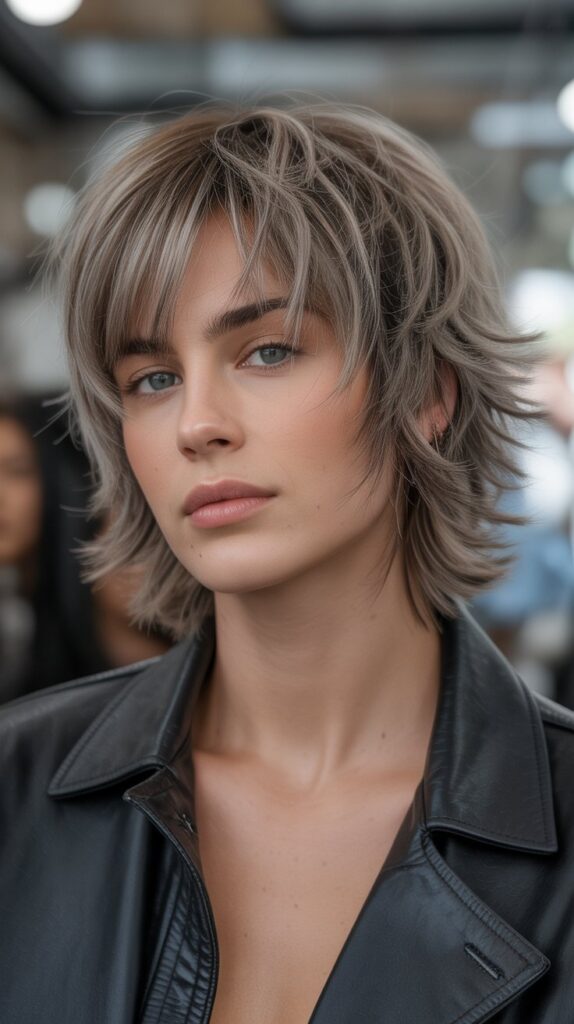
The shag haircut’s signature choppy layers and textured styling paired with light ash brown creates an effortlessly cool, rock-and-roll inspired look that balances edgy structure with sophisticated color choice.
- Shag cuts feature heavily layered construction with shorter pieces throughout that create volume and movement, all of which showcase light ash brown’s dimensional qualities exceptionally well.
- The intentionally messy nature of shag styling prevents ash brown from appearing too formal or uptight, creating perfect balance between cool sophistication and rebellious texture.
- Multiple layers throughout the shag mean the ash brown color appears differently at various lengths, with shorter pieces potentially pulling slightly lighter than the longer underlayers.
- Styling shag cuts requires texturizing products and often diffusing or air-drying to enhance natural texture, making this a relatively low-maintenance style despite its layered complexity.
- The shag’s revival as a contemporary trend pairs perfectly with the timeless nature of ash brown, creating a look that feels both nostalgic and thoroughly modern.
Maintenance Tips for Light Ash Brown Hair
- Color-safe, sulfate-free shampoos preserve ash brown tones significantly longer than regular shampoos by preventing premature color stripping and fading from harsh detergents.
- Cold water rinsing after shampooing and conditioning seals the hair cuticle, locking in color molecules and enhancing shine while preventing premature ash tone fading.
- Heat protectant sprays become non-negotiable for styled ash brown hair, as heat styling without protection accelerates color oxidation and shifts ash tones toward unwanted warmth.
- UV protection products shield ash brown from sun exposure that causes fading and brassiness, particularly important during summer months or in sunny climates.
- Regular trimming every 6-8 weeks removes damaged ends that often appear lighter or brassy, maintaining the integrity of the ash brown color throughout all lengths.
- Avoiding chlorinated pools or using protective swim caps prevents the green tint that can occur when chlorine interacts with ash-toned hair colors.
- Professional glossing treatments restore vibrancy between full color services, depositing ash pigments that refresh the cool tones without requiring complete recoloring.
- Limiting washing to 2-3 times weekly preserves color longevity, as each wash cycle removes some color molecules and contributes to gradual fading.
- Silk or satin pillowcases reduce friction that can cause color fading and damage, helping maintain the pristine quality of freshly colored ash brown hair.
- Clarifying treatments used monthly remove product buildup that can dull ash brown’s reflective quality, though always following with purple-toned products to prevent brassiness after clarifying.
Choosing the Right Ash Brown Shade for Your Skin Tone

- Fair skin with cool or pink undertones pairs exceptionally well with lighter ash brown shades (level 7-8), as the coolness complements without creating harsh contrast.
- Fair skin with neutral undertones can successfully wear the full range of light ash browns, from lighter to slightly deeper shades, due to the neutral base’s versatility.
- Medium skin tones with cool undertones look stunning in classic light ash brown (level 6-7), where the color provides enough contrast without appearing washed out.
- Medium skin with warm undertones should proceed cautiously with ash browns, potentially incorporating warmer highlights to prevent the cool tones from creating an ashy appearance against the skin.
- Olive skin tones often look spectacular in ash brown shades, as the cool undertones create beautiful contrast with the natural warmth in olive complexions.
- Deep skin tones can wear light ash brown successfully, particularly in highlighted or balayage applications where the ash pieces provide striking contrast against richer skin.
- Consulting with a professional colorist who can assess undertones in natural lighting ensures the most flattering ash brown shade selection for individual coloring.
- Testing with temporary color or wigs before committing to permanent ash brown allows experimentation without the commitment of chemical processing.
- Considering lifestyle factors including makeup preferences helps determine ideal ash brown shade, as color choice should harmonize with overall personal aesthetic.
- Seasonal color analysis principles suggest that individuals categorized as “Summer” or “Winter” in color theory particularly suit ash brown’s cool-toned nature.
Cost Considerations for Light Ash Brown Hair

- Initial light ash brown color application typically ranges from $150-$400 depending on hair length, starting color, and salon location, with major metropolitan areas commanding premium pricing.
- Achieving ash brown from dark hair often requires multiple sessions for safe lightening, potentially increasing total cost to $300-$600 when proper hair health preservation is prioritized.
- Maintenance appointments every 6-8 weeks typically cost $100-$250 for root touch-ups and toning, creating an annual maintenance budget of approximately $800-$1,500.
- At-home maintenance products including purple shampoo, conditioning treatments, and glosses add $30-$60 monthly to the overall investment in maintaining pristine ash brown color.
- Highlighting techniques like balayage or babylights generally cost more initially ($200-$500) but require less frequent maintenance, potentially offering better long-term value.
- Box dye alternatives for ash brown at home cost $8-$15 but rarely achieve professional results, particularly regarding the precise ash toning that defines this color family.
- Budget-conscious approaches include choosing low-maintenance techniques like root stretching or shadow roots that extend time between expensive salon visits.
- Many salons offer package deals or memberships that reduce per-visit costs for clients committed to regular maintenance schedules.
- Investing in quality initial color application prevents costly correction services that become necessary when cheaper options result in uneven or brassy results.
- Long-term cost analysis reveals that proper maintenance actually extends color vibrancy, reducing frequency of intensive color corrections and ultimately saving money over the hair color’s lifetime.
Protecting Ash Brown Hair from Environmental Damage

- UV radiation represents one of the primary causes of ash brown fading, breaking down color molecules and causing the cool tones to oxidize toward unwanted warmth.
- Leave-in products containing UV filters create a protective barrier against sun damage, essential for maintaining ash tones during outdoor activities or sunny climates.
- Wearing hats, scarves, or protective styles when spending extended time outdoors shields ash brown hair from direct sun exposure that accelerates fading.
- Chlorine in swimming pools strips ash tones rapidly while potentially introducing green tints, making pre-swim protection with leave-in conditioner or swim caps essential.
- Salt water from ocean swimming can lighten and strip ash brown color, requiring immediate rinsing and deep conditioning after beach activities.
- Hard water minerals accumulate on hair over time, creating buildup that dulls ash brown’s reflective quality and can contribute to unwanted brassiness.
- Installing shower filters that remove mineral deposits and chlorine from water protects ash brown color during daily washing routines.
- Pollution and environmental toxins in urban areas can settle on hair, creating dullness and contributing to color oxidation that shifts ash tones.
- Regular clarifying treatments remove environmental buildup while preserving color when followed immediately with purple-toned conditioning products.
- Indoor heating and air conditioning create dry conditions that damage hair structure and accelerate color fading, making humidifiers beneficial for color preservation.
Styling Products Best Suited for Ash Brown Hair
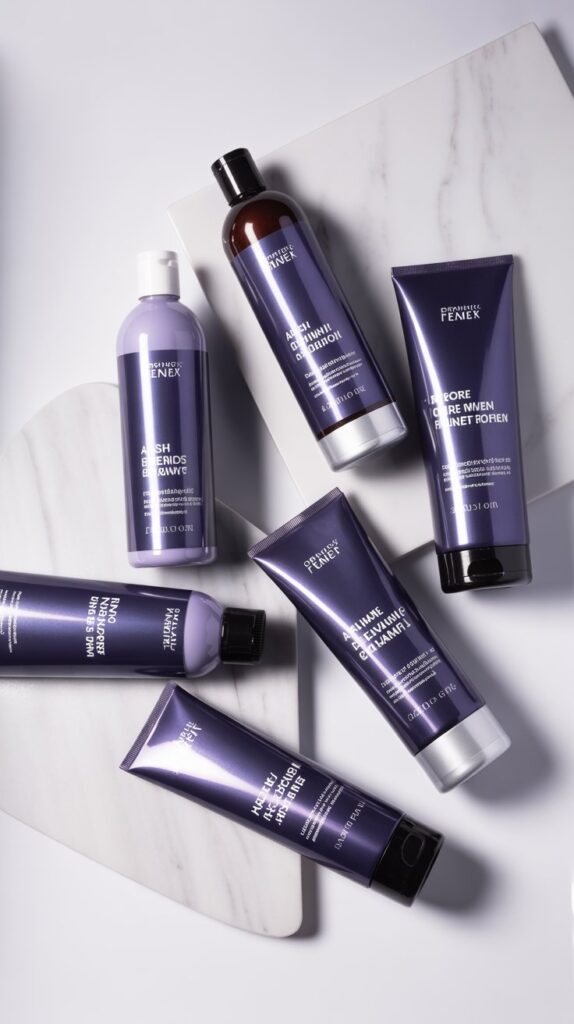
- Purple and blue-toned shampoos specifically formulated for brunettes work best for ash brown, as they contain appropriate pigment concentrations without over-toning like blonde-specific formulas might.
- Color-depositing conditioners in ash or silver tones extend professional toning between salon visits, gradually refreshing cool undertones with each use.
- Sulfate-free styling products prevent premature color stripping that occurs with harsh detergents found in traditional hair care formulations.
- Lightweight oils and serums enhance ash brown’s natural shine without weighing down hair or creating greasiness that dulls the color’s reflective quality.
- Heat protectant sprays with UV filters provide dual protection against thermal styling damage and environmental factors that cause fading.
- Texturizing sprays and dry shampoos in tinted formulas can help blend roots between color appointments while adding volume and style.
- Glossing treatments available for home use deposit shine and ash pigments, though professional glosses typically provide more dramatic and longer-lasting results.
- Alcohol-free styling products prevent the drying effect that contributes to color fading and damage in chemically treated ash brown hair.
- Color-safe hairsprays maintain style without the color-stripping effects of traditional formulas that can accelerate ash tone degradation.
- Investment in professional-grade products typically yields better color preservation results than drugstore alternatives, ultimately extending time between expensive salon color corrections.
Transitioning to Light Ash Brown from Other Colors

- Transitioning from dark hair to light ash brown requires patience and multiple sessions spaced 4-8 weeks apart to safely lighten while preserving hair integrity.
- Moving from warm brown or red tones to ash brown necessitates color correction to remove underlying warmth before achieving true ash results.
- Blonde hair transitioning to ash brown represents the simplest color change, often achievable in a single session with appropriate toning to eliminate any existing warmth.
- Previously colored hair may require color removal or lightening processes before ash brown application can achieve accurate, non-muddy results.
- Box dye removal often precedes professional ash brown application, as drugstore colors can create unpredictable bases that prevent proper ash toning.
- Gradual transitions through highlighting or balayage prove gentler on hair than dramatic all-over color changes, building toward light ash brown over several appointments.
- Protein treatments between transition sessions strengthen hair structure compromised by lightening processes necessary for achieving light ash brown from darker bases.
- Realistic timeline expectations help prevent disappointment, with complete transitions from very dark hair potentially requiring 3-6 months of gradual lightening.
- Professional consultation before beginning transitions provides accurate assessment of hair condition, realistic outcome expectations, and appropriate timeline recommendations.
- Home care during transition periods proves critical, with intensive conditioning and minimal heat styling preserving hair health throughout the color journey.
Common Mistakes to Avoid with Ash Brown Hair
- Using regular shampoo instead of color-safe formulas strips ash pigments rapidly, causing premature fading and requiring more frequent expensive salon visits.
- Over-washing hair more than 3-4 times weekly accelerates color loss, as each wash cycle removes some of the delicate ash pigments that define this color.
- Skipping heat protectant before styling tools exposes ash brown to temperatures that cause color oxidation and shift cool tones toward unwanted warmth.
- Attempting DIY ash brown with box dye rarely achieves professional results, often creating muddy, uneven color or green tints from improper toning.
- Neglecting purple or blue shampoo maintenance allows brassiness to develop between salon appointments, diminishing the sophisticated cool tone that defines ash brown.
- Excessive heat styling above 350°F damages hair structure and accelerates color fading, particularly problematic for maintaining delicate ash tones.
- Ignoring root touch-up schedules allows excessive regrowth that becomes more expensive and time-consuming to correct than regular maintenance appointments.
- Swimming without hair protection exposes ash brown to chlorine and minerals that cause significant color stripping and potential green discoloration.
- Using wrong-toned products like purple shampoo formulated for platinum blonde can over-tone brunette ash shades, creating unwanted purple or gray casts.
- Rushing the transition from dark hair to light ash brown by over-processing causes severe damage that compromises both hair health and color results.
Seasonal Considerations for Ash Brown Hair
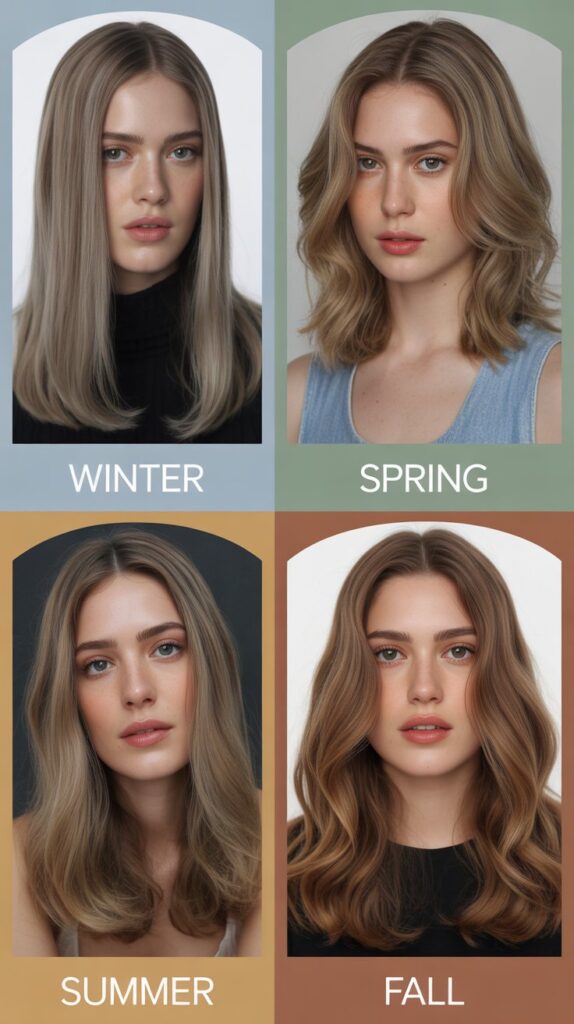
- Summer sun exposure intensifies fading and can shift ash brown toward brassiness, necessitating increased use of UV protection products and purple shampoo.
- Winter indoor heating creates dry conditions that dull ash brown’s shine and accelerate color fading, requiring more intensive hydration treatments during cold months.
- Spring offers ideal timing for major color changes to light ash brown, as moderate temperatures and humidity levels create optimal conditions for color processing and maintenance.
- Fall’s lower UV exposure provides relief for ash brown maintenance, often allowing extended time between toning appointments as brassiness develops more slowly.
- Holiday season styling often involves more heat styling for special events, requiring extra vigilance with heat protectant to preserve ash brown through frequent styling.
- Summer activities including swimming and outdoor sports demand protective measures like leave-in conditioners, hats, and immediate post-swim cleansing to preserve color.
- Seasonal color adjustments can incorporate slightly deeper ash tones in fall and winter with lighter, brighter variations during spring and summer months.
- Humidity variations affect ash brown’s appearance and manageability, with summer humidity potentially enhancing shine while winter dryness creates static and dullness.
- Vacation planning should consider ash brown maintenance needs, potentially scheduling color appointments before trips to ensure fresh color throughout travels.
- Climate-appropriate product selection helps maintain ash brown year-round, with lighter formulas for humid months and richer treatments for dry winter conditions.
Conclusion
The journey through these 27+ stunning light ash brown hair color ideas reveals the remarkable versatility and timeless sophistication this cool-toned shade offers to anyone seeking refined elegance in their hair color choice.
From classic solid applications to creative dimensional techniques like balayage, babylights, and color melting, 27+ Stunning Light Ash Brown Hair Color Ideas encompasses options suitable for every preference, lifestyle, and maintenance commitment level.
The ash brown family’s ability to flatter diverse skin tones while maintaining workplace appropriateness makes it an enduringly popular choice across age groups and style preferences.
Whether you’re drawn to the dramatic contrast of platinum highlights, the subtle elegance of babylights, or the low-maintenance appeal of rooted techniques, light ash brown provides a sophisticated foundation that elevates any look.
By understanding proper maintenance requirements, selecting appropriate products, and working with skilled colorists who appreciate the nuances of cool-toned coloring, you can achieve and maintain stunning light ash brown hair that turns heads and exudes confidence.
The investment in quality application and consistent maintenance pays dividends in the form of gorgeous, healthy-looking hair that showcases the refined beauty only ash brown can deliver, proving that this cool-toned treasure deserves its place among the most coveted hair colors in contemporary styling.
